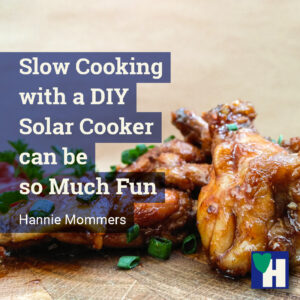
How slow cooking with a DIY solar cooker brought my mind back to my childhood? I have no idea.
But did you also have such fun as a child with a shoelace and a magnifying glass? It was fantastic to try to light the fire by burning the lace with the sun shining through the magnifying glass.
I never thought about that fun again until I started researching solar cookers. Not that we need a magnifying glass for a solar cooker, but the sun is definitely needed.
It’s not that hard to make your own solar cooker. You can also do that with your kids or grandkids, which will be double fun. First the making and then the cooking. Maybe they will even eat those dreaded vegetables if they have had a lot of fun before the meal is ready. 😉
Some of the links are affiliate links. As an affiliate associate, we earn a commission when you purchase any of the products offered through the shared links at no extra cost for you. This helps us maintain this website.
Table of contents
Sustainable sun
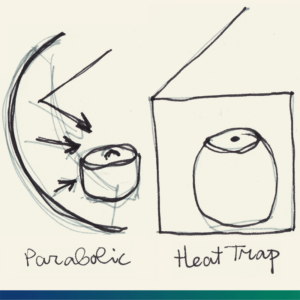
Tom wrote an article the other day about alternative energy – What is Sustainable Energy and Why Must We all Convert to it – in which he talks about solar panels. Yet, the sun can be put to use in other ways as well.
Solar panels convert the sun’s heat into energy that can charge a battery or directly into electricity to run your household appliances. Solar cookers use the principle of concentrating the sun’s heat (parabolic type) or of a heat trap (box type).
There are various models that you can make, of which I describe the simplest here. Assuming we’re not all one of those top-notch handy humans with a shed full of tools.
Sustainable cooking
Slow cooking, the hipster word for low-temperature cooking, became a hype in the past years. Slow cookers also go under the name of crockpots. The cooking technique uses relatively low temperatures – between 45 and 82 degrees C or 113 to 180 degrees F – and a lot of time and is mainly used for meat.
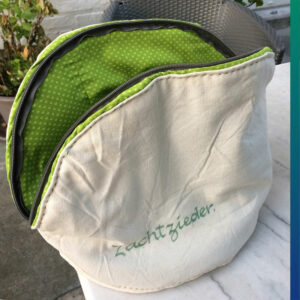
It’s the opposite of the cooking method Tom and I used when we were just married: pressure-cooking. As a working couple, we didn’t have a lot of time, yet we ate time-consuming food like legumes and brown rice as vegetarians. A pressure cooker significantly reduced the cooking time.
Brown rice takes longer to cook than white, refined rice. If we had studied sustainable cooking at the time, we might have encountered a ‘slow-bag’ sooner. A friend of ours made several that work just fine. They look like an old-fashioned tea cozy, but with a bottom and a zipper. Precook the rice and then put it in the bag for some time.
Slow cooking with a DIY solar cooker
“Phew, it’s so hot outside you could cook an egg on the pavement!” You will surely have heard this phrase or a similar one. Well, why cook on the road when you can use the sun’s power and cook in a clean and safe environment using a solar cooker.

A parabolic type
Supplies:
- An aluminum car sunshade;
- Duct tape or Velcro.
Preparations:
- Cut the sunshade in 2 even halves;
- Place one half on the ground as the bottom and put a pan on it;
- Put the other half upright and fold the bottom around it;
- Stick the 2 halves together at the back with duct tape;
- Try out the solar cooker.
If you have found the ideal curves of the 2 halves, it’s best to replace the duct tape with Velcro. Duct tape will eventually come off due to the heat. Another advantage of Velcro is that you can take the solar cooker apart after use and store it flat.
A box type solar cooker
Supplies:
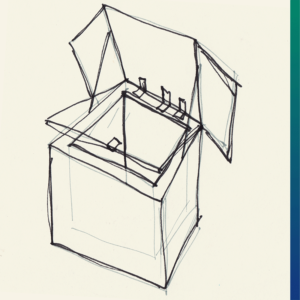
- A cardboard box. A cube-shaped is the easiest to work with;
- Duct tape;
- Styrofoam, or an organic alternative such as Bio-Foam;
- Aluminum foil;
- A glass plate the size of the top of the box;
- 2 metal rods
- Non-toxic glue.
Preparations:
- Cut 3 flaps from the box;
- Cut 5 Styrofoam plates that will fit into the box as isolation;
- Glue aluminum foil on one side of the Styrofoam plates;
- Line the inside of the box with the Styrofoam plates with the foil turned inwards;
- Tape the glass plate to the side where the flap is still on. It might be best to tape the side of the glass so you can’t cut yourself and to make a handle to avoid burning yourself when you open the plate after cooking;
- Tape 2 cut-off flaps to the existing flap and line the insides with aluminum foil. Depending on the kind of box you have, you might need extra cardboard to extend the existing flap to the right size;
- Glue the rods to the sides of the box so the flap stays at an angle. What that angle is, depends on the position of the sun.
Cooking with your solar cooker
You can use either a small pot or a cooking bag to cook using your solar cooker. Keep an eye on your food because, during particularly hot days at the right angle, it can be ready quite quickly.
The temperatures can differ quite a lot. So if you are making something specific, place a thermometer inside. In any case, make sure the cooking temperature is above 68° C or 155° F to kill harmful bacteria.
You can cook just about anything in a solar cooker. For example, you can cook rice and beans together with some vegetables. Or if you want to slow cook chicken, have a look at Tom’s delicious recipe of chicken with mango and adjust the time accordingly.
Slow cooking with friends
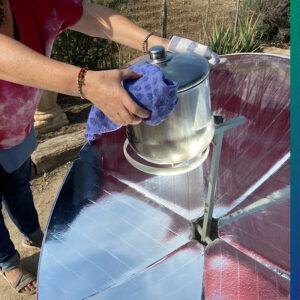
Instead of a barbecue, you can use 1 or 2 solar cookers to party with your friends. The same items you would put on the barbecue can be put inside the solar cooker.
You’ll need the same precautions, such as a wire rack, oven gloves, and a kitchen apron. But you won’t need smelly firelighters and air-polluting wood.
Solar cookers are a great way to save energy, to have a little fun cooking outside, and to teach children that there’s more than one way to cook.
Happy cooking!
By the way, have a look at this WikiHow for more information and an explanation of a top-notch solar cooker.
Have you cooked in a solar cooker? How was it and what did you make?


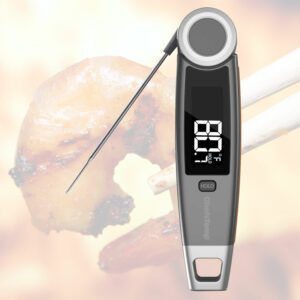
Wow, Hannie! That is really something I was looking for. Great idea! I am thinking about independent energy supply, and I have written about the Backyard Solution, a review.
People can make their own solar panel system in their backyard, even fits a small garden like ours. I would like to have a solar power douche system to connect with your garden water system. Through sunshine, the water warms up, and you can shower with warm water. There are many possibilities, and I am researching them. But the slow cooker is a great idea; only one minus point is that we have more rainy, dark days here in the Netherlands. You have in Spain more sunny days, and that is certainly an advantage. If you find something, please let me know. I am very interested! 🙂
You will see those solar water systems a lot on Spanish roofs! When solar panels on the roof were opposed by the big electricity companies, helped by the rightwing government, a solar water system was economical because it functions independently of the electricity network. As soon as we have a solution for our heating system, we want one of those as well. 🙂
You’re right, it’s quite a difference in the number of sunny days between the Netherlands and where we live. We have 300 out of 365 sunny days. Unbelievable. At the moment I am enjoying those sunny days immensely. Last year, it was often above 40C in August. That’s way too hot for me, even though Tom thrives in those high temperatures. At the moment it’s between 30C and 35C with an occasional 38C. Lovely!
Thanks for your reply, Sylvia, and yes, if I find anything I will let you know. Take care.
Hi Hannie,
Yes, I can remember when I walked around with a magnifying glass, burning everything I could find. Also I used a normal glass, and I had much fun. I think it is a great idea to use a solar slowcooker. The sun gives the energy and as a child I often heard when adults said:”Oh, we could bake an egg. It is so hot!” So, why not using the sun for cooking? And what I learn from your response to Sylvia is that you live in Spain, so you have lots of sunny, really hot days. Great article, Hannie!
Regards, Henk
Thanks, Henk. And yes, we live in Spain, lots of sun. Sometimes even too much, it’s 38C at the moment and tomorrow it’s predicted to be 41C. As we say in Dutch: ‘het is niet goed of het deugt niet”, isn’t it. 😀
There are several projects to bring solar cooking to Africa, did you know? I saw them on Kickstarter and Indiegogo, really clever devices. In rural areas, there is no electricity and the wood they usually use is sometimes dangerous because of bushfires. And the sun is for free. 🙂
Thanks for your reaction and take care.
I had no idea this was even possible! I cook on a daily basis – mostly easy one-pan vegetarian meals because I’m in a rush but this could be a huge time saver and I could experiment with other dishes as well. I’m super curious what hubby will say, he’s the one that’s handy with DIY projects.
Hi Bella, I guess you could manage the one that is made from an old car sunscreen. You just have to cut it into two halves and glue them together. But the other one is more difficult, that’s right. Aren’t you lucky you have a handy husband. 😀
One-pan meals are perfect for a solar cooker!
Thanks for your comment and take care.